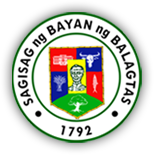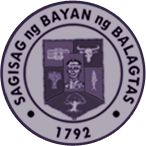History of Balagtas
From the Municipal Planning and Development Office
 As part of the popularity of the province of Bulacan home of the bravest heroes in the history of the Philippines, the town of Balagtas partake the recognition of being the hometown of Francisco Baltazar (otherwise known as Balagtas) one of the greatest Tagalog poet during the Spanish regime in the country. As his name was use to represent the town, a continuous effort to uproot its history is under taken to unleash the town’s rich beginning.
As part of the popularity of the province of Bulacan home of the bravest heroes in the history of the Philippines, the town of Balagtas partake the recognition of being the hometown of Francisco Baltazar (otherwise known as Balagtas) one of the greatest Tagalog poet during the Spanish regime in the country. As his name was use to represent the town, a continuous effort to uproot its history is under taken to unleash the town’s rich beginning.
Contrary to the popular belief, the original name of Balagtas was not Bigaa but “Caruya”. The townsfolk since the beginning of the 16th century used the name “Caruya” to refer to their town, but soon replaced by Bigaa after the establishment of Spanish colonial rule in the Philippine as recalled by the Famous Augustinian historian Pedro Galende.
Though given a new name, Bigaa (tree with big leaves and white flowers) was not recognized as an independent nor a self-governed town. Together with Pandi it was just a part of Bocaue Bulacan and was under the latter’s jurisdiction.
As the written history of Balagtas was organized, it started to mirror the tyrannical rule of the Spaniards and the abusive treatment they exhibit to its natives. As the situation worsen, the discontented and harassed populace begin to from groups to present their grievances to the foreign ruler. This revolutionary movement was lead by Eusebio Roque ( also known as Maestrong Sebio) as he organized a band of insurectos at barrio Cacarong. Although full of enthusiasm, his movement was short lived due to his own death and his members denied their association with him because they feared that they might be the next target of the pacification tactics of the Spaniards. From the first attempt to be free, Bigaa witnessed the continuous effort of the Filipinos to gain independence. One of which is the battle fought by Gregorio del Pillar and the Katipuneros in “Real de Cacarong”. These events reflect the unyielding hope of the Filipinos that someday they are going to be recognized as one free and self-sufficient nation.
As the aim to be self- governed intensifies, Don Lorenzo Galves together with the civic youth organizations, worked for the cost of recognizing Bigaa as a municipality. Finally, on New Year’s Day of 1912, Bigaa faced the new era of self-governance. On the other hand, Pandi remained part of Bigaa as one of its barrios. When the Philippines gained independence in 1946 from the United States, Pandi was given its charter as a separate municipality and was approved during the presidency of the late Sergio Osmenia, Sr.
With Francisco Baltazar’s legacy to the Filipino race, the people of Bigaa moved for the renaming of the town after him. On September 28, 1965, Bigaa was given a new name through a Bill authored and sponsored by Congressman Teodulo Natividad. In June 18, 1966 the Philippine Congress approved R.A 4702 renaming the town Bigaa to Balagtas in honor of the renowned Tagalog poet Francisco Baltazar ( also known as Francisco“ Kiko” Balagtas). The pride of the town was born in Panginay Bigaa Bulacan on April 02, 1788 to Juan Baltazar and Juana dela Cruz. His contribution to Philippine Literature, played a major role in awakening the Filipino’s aspiration to be independent. His masterpiece “Florante at Laura”, depict the degrading and inhumane system of Spanish governance in the Philippines. His legacy upheld by the people of town is shown thorough their leadership and as they commit themselves to the achievement of national goals.
In commemoration of this significant achievement, the date of Baltazar’s birth was set as provincial holiday.
The following are the people who occupied the position of Town President or Mayor:
|
Spanish Era:
|
American Occupation up to the Philippine Independence:
|


